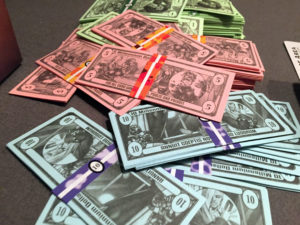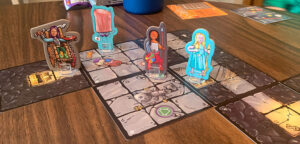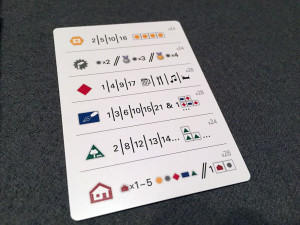The price of buying boardgames is dramatically increasing. Supply chain issues, shipping costs, increases in material costs… none of this is news. Games that used to cost $30-$40 will now cost you $50-$60. Fine. I get it. But if you are going to ask me to spend $60 or more on your game, I certainly have expectations for the game you are publishing.
10. Inclusion of a useful insert/organizer
When I open my game, I will be very disappointed if I see the Fantasy Flight Games Death Star Trench Run “organizer.” That insert is in place for holding my components in place UNTIL I open the game. These days I expect a decent insert or organizer to hold my components in place AFTER I opened the game. I am not necessarily expecting Game Trayz in every game I own. I am looking for something that will hold my components in place, including sleeved cards. Something like Ark Nova, which includes two simple sets of trays for organizing the cardboard tokens, or Dollars to Donuts with its excellent plastic tray.
9. No paper money

SAY NO TO PAPER MONEY (except for you Millennium Blades, we cool)! Thankfully, this has pretty much died out, but still rears its ugly head every once in a while, especially on Kickstarter campaigns with inexperienced designers/publishers. Cardboard tokens, chips, metal coins… anything but paper money. I am begging you.
8. Cards are sealed with a starter piece for opening
I love when cards are sealed securely. I HATE when it does not have a starter piece on the one side to assist with opening. Nothing infuriates me more than trying to open my cards and having to pick at one of the corners, use my teeth, or hand them to Tony to cut open with his Swiss Army knife. This is especially true for cards smaller than a poker card—for whatever reason, opening those is even harder for me. I should NOT have to carry around a cutting utensil to open my games!
7. All expansion components have a symbol
Dear publishers,
In order to sell an expansion, you are going to print out new components for game. We are going to buy those components and, most likely, toss them in with the base game to save room on our collapsing shelves. Please include an expansion symbol SOMEWHERE on the components so that we can easily separate them later. Thank you!
Sincerely,
Pretty much every gamer who buys expansions
6. Box size is not egregiously large for no reason
 Splendor. Stop it. No one would have judged you differently if your box size was smaller. I understand the need to have a captivating box; however, it is no longer 2014. With increased shipping costs and wanting to be more environmentally friendly, please maintain a reasonable box size to accommodate the contents of the game and potentially an expansion or two. I should not be able to simultaneously store your game components and a cat in your box.
Splendor. Stop it. No one would have judged you differently if your box size was smaller. I understand the need to have a captivating box; however, it is no longer 2014. With increased shipping costs and wanting to be more environmentally friendly, please maintain a reasonable box size to accommodate the contents of the game and potentially an expansion or two. I should not be able to simultaneously store your game components and a cat in your box.
5. Well-organized rulebook that includes an index for key terms/ideas
I understand that well-organized is subjective, but we all have those rulebooks that we hate where a key concept is explained one time, but it is buried in a section that has NOTHING to do with that concept. Here is my suggested layout:
• Game background/Intro
• Objective/How to win
• Set up
• High level overview of a turn divided into key parts of the turn
• Detail explanation of each key part of the turn
• End Game trigger(s) and scoring
• Appendix explaining cards/powers/bonuses
• Index
This is the most important part. All keywords/concepts should be bolded. Every bolded word should have an entry in the index so that key concepts can quickly be found.
4. Diverse player options

Examples:
• Architects of the West Kingdom player boards are double-sided to include multiple races and genders for each player color.
• Everdell released a promo pack, replacing the husband and wife cards with harvester and gatherer cards that included a space to write your name and title.
• Sword and Sorcery included both a male and female version of every class.
It’s funny how sometimes you don’t see a problem until it is your problem. I will never forget the day my step-daughter was unhappy about the game we were playing because there were only male characters to choose from. I never thought about that before then, and I have never NOT thought about that after. I see no reason why board gaming cannot be inclusive.
3. Player aids
 Rule number 1: Always include player aids. If you are not doing that today, please change your thinking. And no, printing a summary on the back of the rulebook does not count. I don’t want Brian and his greasy fingers touching my rulebook. He can ruin the player aid.
Rule number 1: Always include player aids. If you are not doing that today, please change your thinking. And no, printing a summary on the back of the rulebook does not count. I don’t want Brian and his greasy fingers touching my rulebook. He can ruin the player aid.
Rule number 2: Take the number of player aids needed for one player and multiply it by the number of players your game supports. If you have a four-player game and a player needs two different player aids, print eight. You already printed 150+ cards in your game. Make it 158 so that all four players can have their own player aids.
2. Quality game components that will hold up to play
The days of punching out paper-thin cardboard chits that you have to trim with an Exacto knife should be behind us. Card technology has improved dramatically. I should not have problems punching out cardboard components or having my cards scuffed after two shuffles. I am not looking for Chip Theory Games’ level of component quality. I am looking for components that will last at a fair price.
1. Color blind friendly game pieces as well as the use of symbols
Please utilize colors for your components that will least likely trigger a color-blind issue. The colors you can use will be more difficult as your player count increases, but I would recommend playtesting with color-blind testers to get their feedback. I have several games where I cannot easily tell the difference between blue and purple because the differentiation is not distinct enough.
In addition, PLEASE use symbols to assist color-blind players wherever possible, be it on the components, in your rules, or on the game board. For transparency, I am not making this #1 for selfish reasons. While I am red/green color blind, the severity of my color blindness is very low. Outside of someone simply not wanting to play board games, I believe being non-color blind friendly is the biggest barrier to entry to board gaming. Luckily, it is easily solvable.
Source: Board Game Quest




